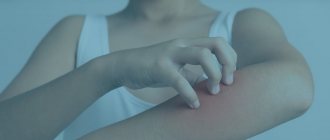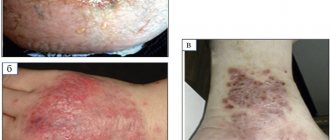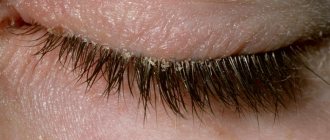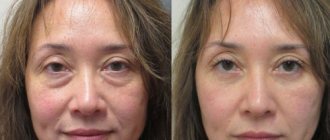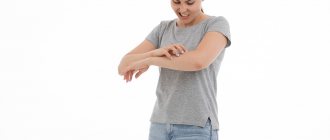A small child was born. His body begins to adapt to new conditions. Contact with external factors does not always have a positive impact on the baby’s health. Eczema in children is an allergic skin disease with a pathological process of inflammation in the upper layers of the epidermis. It can occur both in the first months of life and during adolescence. Due to itching and various rashes, eczema causes discomfort. An acute inflammatory allergic reaction can accompany diathesis, the presence of which suggests the body’s tendency to exhibit allergic reactions. The nature of the disease is non-infectious with a recurrent nature.
Causes
Eczema in a child can have different causes, but one of the main ones is heredity. An allergic reaction can be activated upon contact with a certain irritant in the form of cosmetics, fragrances, pet hair, etc. Statistics show that if parents have an allergy in any of its manifestations, the probability of inheritance by the child is 40%. Eczema of the hands in a child or any other form of pathology has different causes of development, which are difficult to define in a single list. Each organism and case is individual. Eczema often accompanies the presence of diabetes mellitus and chronic gastrointestinal diseases. The main reasons may be:
- helminthic infestation;
- endocrine pathologies;
- manifestation of dysbacteriosis;
- infectious pathologies;
- reaction to dust and pollen;
- food (for breastfeeding);
- congenital immunodeficiency;
- artificial feeding.
Weeping eczema
Systemic therapy
Therapy for weeping eczema is selected individually, taking into account the presumed causes of the disease, the severity of clinical manifestations, and the presence of concomitant pathologies or complications in the patient.
To reduce sensitization of the body, patients are recommended to follow a hypoallergenic diet, from which fatty fish and meats, oysters and other seafood, coffee and cocoa products, citrus fruits, tomatoes, and legumes are excluded. If the exacerbation of the disease is associated with the influence of exogenous factors, their elimination is a necessary condition for the success of treatment. Given the specific situation, patients may need to change their place of work, eliminate household allergens, or move to more suitable climatic conditions. Complex treatment of weeping allergic dermatosis requires the use of a number of drugs:
- Antihistamines
. To eliminate skin itching in the acute phase, first-generation histamine blockers are used, and after relief of symptoms, it is possible to continue treatment with second- and third-generation medications. - Desensitizing drugs
. Solutions of calcium and sodium thiosulfate are used. The treatment reduces vascular permeability, has an anti-inflammatory effect, and normalizes metabolic reactions in the dermis. - Cell membrane stabilizers
. To enhance the effectiveness of antihistamines, treatment with mast cell membrane stabilizers is indicated. Some authors recommend the use of omena-3 polyunsaturated fatty acids to normalize the structure of cell membranes. - Glucocorticosteroids
. For generalized forms of weeping eczema and no effect from other treatment options, hormones are used in pulse therapy or long-term use. - Immunocorrective agents
. Rational immunocorrection is prescribed to alleviate the condition of a continuously recurring form of weeping eczema. Treatment includes thymus preparations and leukopoiesis stimulants. - Antibiotics
. Treatment with antibacterial agents is required for the microbial form of dermatosis and the proven infectious-allergic nature of the disease.
Since various somatic disorders play a role in the pathogenesis of weeping eczema, treatment includes the correction of these pathologies. To normalize the functioning of the digestive tract, it is advisable to use enzyme replacement therapy, probiotics and synbiotics, and vitamin and mineral complexes. To balance the state of the central nervous system, mild sedatives are included in the treatment regimen; tranquilizers and antidepressants are prescribed for certain indications.
Local therapy
In the weeping phase, lotions with astringents are used, which reduce exudation, promote faster appearance of crusts and regression of the disease. In the acute stage, daily procedures lasting 1-1.5 hours are prescribed, which involve constant changing of the dressings as they dry. Then they proceed to applying ointments with topical corticosteroids, antiseptics, and calcineurin inhibitors.
Of the physiotherapeutic methods of treatment, the most effective is selective ultraviolet therapy, during which irradiation is carried out with light of a narrow range (311 nm). Low-intensity laser irradiation of the red or infrared spectrum, electropuncture of biologically active points, and local hyperthermia are also performed. At the stage of remission, ozone therapy, balneotherapy, and peloid therapy have a good effect.
Eczema in children and its types
The classification of the disease is based on the manifestation of clinical features. Each variety has distinctive symptoms and a specific location. Eczema occurs on children's fingers, on the head, around the ears, on the legs and throughout the body in general. The lesions can be randomly located and have different shapes and symptoms. Depending on the etiology and signs of the disease, the following forms are distinguished:
- seborrheic;
- true (idiopathic);
- microbial;
- atopic;
- coin-shaped;
- weeping;
- dry;
- dyshidrotic;
- viral;
- herpetic.
Seborrheic form in small children
Seborrheic eczema in children is provoked by neuroendocrine disorders and seborrhea itself. Affected areas are rich in sebaceous glands: scalp, back, nose, eyebrows, area behind the ears and between the shoulder blades. Appears in the form of yellowish and whitish fatty scales. The chronic form of the disease can be treated with a transition to long-term remission.
True (idiopathic)
The classic form of manifestation of the disease. It is difficult to determine the root cause of its occurrence. It is recurrent and chronic. This form is characterized by a focal location on the back of the feet and hands, buttocks, chest and face. The spots have an irregular shape and resemble the islands of an archipelago on a map. Such lesions contrast next to healthy areas of the skin. The area affected by eczema may increase over time. Stagnant cracks, scales and constant itching are typical signs.
Microbial form of eczema
When the skin is damaged, scratches and wounds form. There is a high probability of pathogenic microorganisms entering them, which subsequently provoke the development of eczema. We are talking about staphylococci and streptococci. These microbes, once in an environment favorable to them, begin to actively multiply. As a result, large inflamed areas of skin with purulent crusts appear. Possible formation of weeping erosion. Microbial eczema is located asymmetrically, and its contours are round or scalloped. The main locations are the extensor surface of the limbs and the back of the bones.
Coin-shaped type of pathology
Monetoid or nummular eczema in children appears on the skin in the form of elongated plaques. In appearance they resemble a coin. Skin lesions range from 3 to 5 cm in diameter with pink-red plaques and bluish vesicles. The edges are slightly raised above the skin. The rash and peeling cause discomfort and itching, so children often scratch such lesions. With a secondary infection, coin-shaped eczema in children can fester.
Atopic form and its features
It is worth knowing that the atopic form of eczema and the same dermatitis are not synonymous. It most often appears in infancy and before the age of 5 years. The atopic form occurs in children upon contact with an allergen that is aggressive to the body. If the affected area is too dry, it may become inflamed and very itchy. The pathology is localized in the chest area, as well as in the bends of the arms, legs, and neck.
Wet and dry varieties
Weeping eczema appears in a child in the form of blisters on the skin with serous internal fluid. When they come into contact with clothing, they burst, forming soggy crusts. Lesions on the skin are difficult to heal, adding burning and itching sensations to the overall well-being. A severe case when various infections occur. The disease affects the skin of the hands, face and neck in children. The opposite type of disease is dry eczema. With it, the skin becomes very dry, even cracking.
Dyshidrotic form of pathology
Dyshidrotic eczema in children occurs on the hands and feet. Various allergens provoke its appearance. The rash is itchy. It can manifest itself in three forms: acute, recurrent and chronic. With a milder type of the disease, peeling, redness, followed by the formation of a weeping surface are observed. And in severe cases, blisters may appear. Upon physical contact, they burst, forming a crust on the surface of the skin.
Viral form of the disease
Viral infections provoke the development of a rash, which is often confused with other pathologies, for example, urticaria, atopic dermatitis or an allergic reaction to medicinal syrups. According to statistics, 90% of children suffer from sudden exanthema along with the underlying infectious disease. Viral eczema in children is accompanied by swelling of the skin. The rash can appear on different parts of the body. Eczema often occurs on a child’s face, legs, and arms. It is a self-limiting disease. No specific treatment is required.
Herpetic form of pathology
Occurs against the background of infection with various subtypes of herpes. The disease is complex. Develops against the background of immune disorders. A rash in the form of blisters appears on the child's skin. The internal contents are in the form of serous-bloody fluid. There are erosive and ulcerative skin lesions in young children.
Why does eczema develop?
Medical science does not yet have a clear answer to this question.
There are several key points:
- Hereditary hyperreactivity of the skin. That is, in response to a minor impact, an inadequately significant reaction occurs.
- Functional disorders of various systems (nervous, endocrine, digestive), both congenital and acquired; changes in trophism (nutrition) of tissues.
- Sensitization, that is, increased sensitivity (aka allergy) to various agents. They can be external: chemicals, medicinal, food, household, industrial, biological, microbial allergens. And also come from the internal environment of the body: products of altered metabolism, microbial allergens from foci of chronic infection.
For each type of eczema, certain factors are of greater specific importance.
Symptoms and clinical picture
Eczema in children begins with the appearance of rashes on the skin. In some cases, there may be malaise and fever, but mostly discomfort in health occurs due to local reactions. Depending on the type of pathology and the complexity of the course of concomitant diseases, the clinical picture will differ. The location of the affected skin areas is also important. Eczema on the fingers in children occurs in the dry form of the pathology. If it’s on the face, it means there may be a history of viral origin. The clinical picture is different for each variety, but the general symptoms are as follows:
- rashes of various etiologies;
- focal peeling;
- red-pink spots;
- neoplasms in the form of blisters;
- itching and because of this moodiness;
- decreased appetite;
- general malaise, weakness.
When to see a doctor
It is recommended to consult a doctor with a specialization in dermatology if any type of rash appears. This may be eczema on the child's head or on the back, arms or legs. At JSC "Medicine" (clinic of academician Roitberg) in the Central Administrative District they work with all types of skin pathologies in children. You should not self-medicate. A dermatologist helps make the correct diagnosis. Seek advice if the rash begins to spread across the epidermis, rashes with blisters and contents in the form of serous fluid appear. Severe itching is also a reason to visit a doctor. This symptom can cause particularly severe discomfort, disrupting the baby’s sleep and peace of mind. Some types of eczema require concomitant treatment of underlying diseases. An example would be herpetic or microbial eczema.
Symptoms of eczema on the head
Scalp eczema, depending on the cause, manifests itself with different symptoms, and treatment may vary, but there are also common symptoms (see photo). Symptoms of dermatitis include
- Irritation,
- Redness of certain areas of the skin,
- Dryness, flaking, or vice versa, weeping,
- Rash of various shapes,
- Skin itching.
With atopic dermatitis, the head most often affects children in the first year of life. Lesions are located on the cheeks, behind the ears, and in the folds of the neck. Itching is characteristic, which forces the baby to scratch the affected areas, and these sensations intensify at night. The cheeks turn red, a rash, cracks, ulcers, and clear discharge appear. An infection may occur.
In the contact type of the disease, the damage has clear boundaries and develops only in the area that came into contact with the trigger substance. Thus, nickel in jewelry leads to inflammation on the earlobes, around the nose or eyebrow piercing. If you are allergic to a component of a cosmetic product, irritation will be strictly in the area of its application. Eye shadow causes periorbital changes (around the eyes), hair dye - on the scalp, shaving cream - in the lower area of the face. Features of the symptoms include severe redness and swelling; with severe allergies, the rash turns into ulcerations, and pain is noted. Eczema of this form is severe, the skin on the head is deeply damaged, and treatment can be very difficult.
Seborrheic dermatitis differs in that the peeling is more pronounced than other symptoms. The skin scales mix with sebaceous secretions, which are secreted in excess, and form greasy yellowish or grayish crusts on the head, behind the ears, on the wings of the nose, and on the forehead. The scabs are easily removed, revealing inflamed pinkish skin. Itching is characteristic, and scratching makes the manifestation of symptoms even stronger. In infants, due to the immaturity of the regulation of the sebaceous glands, milky crusts, or gneiss, are formed, which by nature are also seborrheic dermatitis. This condition is only a cosmetic defect and does not cause any concern to the baby.
Diagnosis of the disease in children
The basis for diagnosis is the clinical picture. After examination and medical history, the doctor makes a preliminary diagnosis. To confirm it, additional studies and tests are prescribed. In complex cases, laboratory tests help to correctly determine the pathology. Eczema in a child can have different causes, so the therapy will be different. The list of analyzes includes:
- blood tests (general and biochemical);
- general urine analysis;
- allergy and immunological tests;
- skin patch tests;
- erythemometry;
- analysis of skin flakes for fungus (scraping).
Eczema in children and treatment
Treatment is prescribed by an allergist or dermatologist depending on the results of the examination and tests. Correctly identifying the causes of eczema on a child’s body is the key to successful therapy. The main rule is to exclude contact with the allergen and other provoking or potentially dangerous factors: pets, pollen, household chemicals for washing clothes and linen, food. If the child is breastfed, then the reason may lie in the mother’s diet, then she needs to reconsider her diet. Small children scratch the rash with their nails because of itching. Eczema on a child’s hands is easily accessible, so it is easier to damage the skin than on the back or legs. Keep an eye on this by performing hygiene procedures and care in a timely manner. The prescribed therapy should help eliminate the cause of the disease, relieve or alleviate symptoms, and heal the skin.
What is included in the treatment
Treatment depends on the form of the pathology. For example, dyshidrotic eczema in children is treated locally in the form of ointments. If we talk about the general principles of therapy, it includes the following:
- drug treatment;
- physiotherapeutic procedures;
- hypoallergenic diet;
- normalization of the daily routine;
- immunomodulatory therapy.
Eczema on the legs and arms of a child, including other parts of the body, may go away on its own in young children. This is relevant if the disease has mild symptoms and there is no significant itching or discomfort. In such cases, it is recommended to simply observe hygiene standards and observe. In case of severe itching, doctors prescribe special ointments and pharmaceutical talkers. In the cold season, spots need to be covered to minimize the aggressive effects of temperature, sun, and wind. Coin-shaped eczema in children and other forms of pathology should be observed by a dermatologist to prevent the situation from worsening.
The role of diet in the treatment of eczema
Eczema on a child’s legs or cheeks, back, or chest can develop due to food allergies. In this case, you need to follow the principles of dietary nutrition. If the child is under 6 months of age, the cause may be the early introduction of cow's milk into complementary foods. It is recommended to replace it with a dry analogue or goat. Older children may have an expanded list of allergens. It will help to observe what specific foods the symptoms worsen after. Eczema in children requires treatment under the supervision of a doctor, but dietary nutrition will never be superfluous in such situations. Children of preschool and school age are recommended to eat a diet that includes the following items:
- first courses in the form of various soups;
- gluten-free products;
- vegetable broths;
- various cereals;
- mineral water and light-colored juices;
- fresh fruits and vegetables every day;
- fermented milk products (kefir, fermented baked milk, cottage cheese);
- dried fruits.
How to prevent eczema from recurring
When treating eczema, follow all doctor's instructions. Your doctor may recommend the following ways to prevent eczema from recurring:
- Bath your child no more than three times a week.
- The duration of bathing should be no more than 15 minutes.
- Use a mild, medicated, unscented cleanser for bathing.
- After bathing, moisturize your baby's skin with a special unscented cream or ointment prescribed by your doctor.
- The baby's skin needs to be moisturized at least twice a day (in case of exacerbations, up to 5-6 rubles/day). This can be done when changing diapers. Follow other recommendations for caring for children's skin.
- To wash children's clothes, use a hypoallergenic, odorless, soft detergent for children.
- Children's clothing should be made of soft fabric. Avoid wool and other rough fabrics.
- To prevent your baby from accidentally scratching himself, trim his nails carefully. To prevent him from scratching eczema spots, put cotton mittens on his hands.
Traditional medicine to help with eczema in children
Eczema in children requires gentle treatment. It is not always possible to use complex ointments, various antihistamines and corticosteroids. This is a burden on the child’s body that can be avoided in uncomplicated stages of the disease. Traditional medicine can help relieve itching, swelling, and heal the surface of the rash. Eczema on a child's legs or other parts of the body can be treated with an oatmeal solution. Just add a couple of spoons to the water while bathing. You can dilute oatmeal in a glass, then apply cotton swabs soaked in the solution to itchy and inflamed areas.
Eczema on a child’s hands can be treated well with potato juice and its pulp. You need to grate one tuber, moisten a small piece of gauze in the resulting mass and make an application. It should be applied to the affected areas for 10 days. Potato juice has special biological antimicrobial and analgesic properties. Dyshidrotic eczema in children can also be effectively treated with folk remedies. Potatoes are a good way to relieve itching symptoms. If a child has problems with the wet form of the disease, traditional medicine recommends using Kalanchoe juice applications. Remember that any means may have both indications and contraindications. Choose appropriate treatment methods only after consulting your doctor.
True eczema
Can start at any age. In most cases, it is observed in people with the so-called atopic constitution (predisposition).
Some of these patients suffer from atopic dermatitis, and, accordingly, eczema acts as its manifestation. Another part either had manifestations of atopic dermatitis in the past (usually in infancy) or had other atopic diseases (bronchial asthma, hay fever).
In addition, atopic diseases can occur not in the patient with true eczema, but in his blood relatives.
Features of manifestations of true eczema
The rash, which has all the typical features of eczematous, is located symmetrically. The arms, upper half of the torso, and face are most often affected. But the process can spread to other parts of the body, up to the development of a complete lesion.
Provoking factors
The development and exacerbations of true eczema are promoted by psycho-emotional stress, diet disorders, contact with allergens, and disruption of the protective properties of the skin.
Complications of true eczema
Eczema is often complicated by a pustular infection (pyoderma). The process itself, as well as scratching the skin, violates its integrity and facilitates the penetration of staphylococci, streptococci and other “living creatures” that are present in excess on the surface of the skin.
Improper skin care and irrational treatment can lead to the development of erythroderma. This is a condition where the entire surface of the skin is affected. It is accompanied by a general reaction of the body: increased temperature, enlarged lymph nodes, the appearance of symptoms of intoxication and disturbances of all types of metabolism.
How to make an appointment with a dermatologist
Eczema in children requires treatment by a dermatologist with regular monitoring of the condition. At JSC "Medicine" (clinic of Academician Roitberg), the appointment is carried out by an experienced specialist, with whom you can make an appointment by phone. Getting your child to the doctor will not be difficult. Convenient location in the center of Moscow allows you to arrive by metro. Nearby are the following stations: “Mayakovskaya”, “Novoslobodskaya”, “Chekhovskaya”, “Belorusskaya”, “Tverskaya”. Be sure to visit a dermatologist for routine and preventive examinations at the address: 2nd Tverskoy-Yamskaya Lane, building 10.
You can also make an appointment on the website using the “Make an appointment with a doctor” form. In it you need to fill in the fields with your name and contact phone number. After sending the application, the clinic administrator will call you back to confirm the date and time of the consultation. At JSC “Medicine” (academician Roitberg’s clinic), a staff of doctors of various specialties works with children who can help examine eczema on the child’s body and prescribe adequate treatment for the baby’s recovery.
Bibliography
- Adaskevich, V. P. Itchy skin. Dermatological and interdisciplinary phenomenon / V.P. Adaskevich. - M.: Binom, Panfilov Publishing House, 2014. - 272 p.
- Bork, Conrad Skin diseases. Diagnosis and treatment. Atlas and manual / Conrad Bork, Wolfgang Breuninger. - M.: Medical literature, 2015. - 294 p.
- Barlerin JI. Diagnosis of autoimmune dermatoses.// “Veterinarian”, N5, 6, 1998.-P. 20-23.
- Baumann, Leslie Cosmetic Dermatology. Principles and Practice / Leslie Baumann. — M.: MEDpress-inform, 2016. — 696 p.
- Belikov N.A., Goryainov G.I., Solomennikov A.V. and others // Abstracts. Dokl. IV Rep. Conf. “Sorbents for medical purposes and the mechanisms of their therapeutic action.” Donetsk, 1988. pp. 5-6.
- Zimina I.V. and others. Immunology. N 1. 1994.
- Zudin B.I. Skin and venereal diseases. Textbook. Ed. 2nd, revised and additional - M.: Medicine, 1996, 256 p.
- Masycheva V.I. and others. Wound-healing effect of chitosan.// Veterinary Medicine, 1998, N 7. P. 49-52.
- Eczema and contact dermatitis. - Moscow: SINTEG, 2009. - 965 p.
